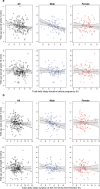Effect of maternal sleep on embryonic development
- PMID: 36224237
- PMCID: PMC9556600
- DOI: 10.1038/s41598-022-21516-6
Effect of maternal sleep on embryonic development
Erratum in
-
Author Correction: Effect of maternal sleep on embryonic development.Sci Rep. 2024 Apr 3;14(1):7836. doi: 10.1038/s41598-024-58405-z. Sci Rep. 2024. PMID: 38570583 Free PMC article. No abstract available.
Abstract
The concept of developmental origin of health and disease has ignited a search for mechanisms and health factors influencing normal intrauterine development. Sleep is a basic health factor with substantial individual variation, but its implication for early prenatal development remains unclear. During the embryonic period, the yolk sac is involved in embryonic nutrition, growth, hematopoiesis, and likely in fetal programming. Maternal body measures seem to influence its size in human female embryos. In this prospective, longitudinal observational study of 190 healthy women recruited before natural conception, we assessed the effect of prepregnant sleep duration (actigraphy) on the fetal crown-rump-length (CRL) and yolk sac size (ultrasound). All women gave birth to a live child. The prepregnancy daily sleep duration had an effect on the male yolk sac and CRL at the earliest measurement only (7 weeks). I.e., the yolk sac diameter decreased with increasing sleep duration (0.22 mm·h-1d-1, 95%CI [0.35-0.09], P < 0.01), and CRL increased (0.92 mm·h-1d-1, 95%CI [1.77-0.08], P = 0.03). Since there was no association at the second measurement (10 weeks), and in the group of female fetuses at any measure point, we suggest a sex- and time-dependent embryonic adaptation to sleep generated differences in the intrauterine environment in normal pregnancies.
© 2022. The Author(s).
Conflict of interest statement
The authors declare no competing interests.
Figures




Similar articles
-
The human yolk sac size reflects involvement in embryonic and fetal growth regulation.Acta Obstet Gynecol Scand. 2019 Feb;98(2):176-182. doi: 10.1111/aogs.13466. Epub 2018 Nov 1. Acta Obstet Gynecol Scand. 2019. PMID: 30218536
-
Periconception maternal characteristics and embryonic growth trajectories: the Rotterdam Predict study.Hum Reprod. 2013 Dec;28(12):3188-96. doi: 10.1093/humrep/det375. Epub 2013 Oct 8. Hum Reprod. 2013. PMID: 24105824
-
Normal ranges of embryonic length, embryonic heart rate, gestational sac diameter and yolk sac diameter at 6-10 weeks.Fetal Diagn Ther. 2010;28(4):207-19. doi: 10.1159/000319589. Epub 2010 Sep 18. Fetal Diagn Ther. 2010. PMID: 20847544
-
Limitations of current definitions of miscarriage using mean gestational sac diameter and crown-rump length measurements: a multicenter observational study.Ultrasound Obstet Gynecol. 2011 Nov;38(5):497-502. doi: 10.1002/uog.10109. Epub 2011 Oct 13. Ultrasound Obstet Gynecol. 2011. PMID: 21997898
-
Ultrasound features of normal early pregnancy development.Curr Opin Obstet Gynecol. 1995 Dec;7(6):493-504. Curr Opin Obstet Gynecol. 1995. PMID: 8620086 Review.
Cited by
-
Association Between Sleep Quality and Duration During Pregnancy and Risk of Infant Being Small for Gestational Age: Prospective Birth Cohort Study.Healthcare (Basel). 2024 Nov 29;12(23):2400. doi: 10.3390/healthcare12232400. Healthcare (Basel). 2024. PMID: 39685022 Free PMC article.
-
Maternal physical activity affects yolk sac size and growth in early pregnancy, but girls and boys use different strategies.Sci Rep. 2023 Nov 20;13(1):20246. doi: 10.1038/s41598-023-47536-4. Sci Rep. 2023. PMID: 37985885 Free PMC article.
-
Umbilical cord length and neurodevelopmental disorders, a national cohort study.PLoS One. 2025 Apr 23;20(4):e0322444. doi: 10.1371/journal.pone.0322444. eCollection 2025. PLoS One. 2025. PMID: 40267150 Free PMC article.
References
Publication types
MeSH terms
LinkOut - more resources
Full Text Sources

